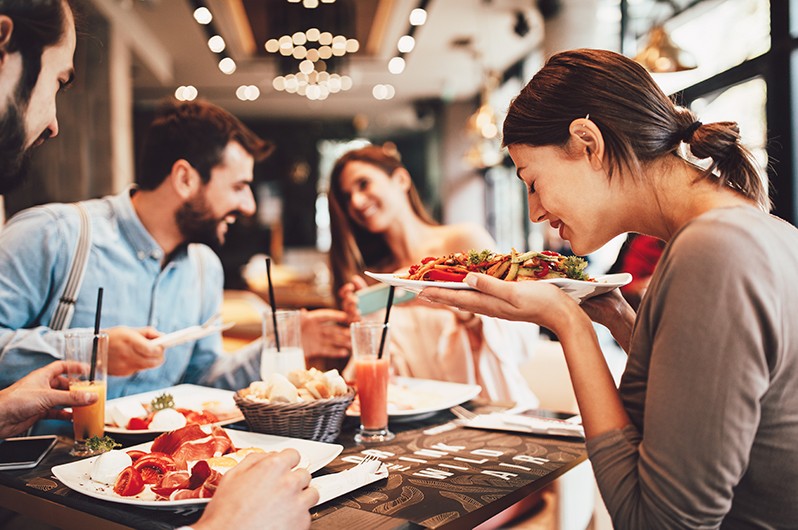Increase Profits With a Restaurant Marketing Budget

Running a restaurant requires a lot of hard work. When you’re focused on serving great food, providing an outstanding customer experience and how to keeping employees happy, it’s easy to get bogged down. But there are other important facets to making sure your restaurant is successful – like marketing.
Deciding how to market your restaurant, how much to spend and where to advertise requires a knowledge of your customers, as well as your restaurant – which is not always easy. We’re here to help you figure out how best to plan your 2020 restaurant marketing budget, along with showing why marketing is essential for your restaurant’s prosperity.
Restaurant Marketing Cost
Paid advertising is very common in most industries, including foodservice. According to Toast’s 2019 Restaurant Success Report, 67% of restaurants pay for social media ads; 53% pay for community, event, or charity sponsorships; 42% pay for Google or search engine ads; and 32% pay for newspaper or magazine ads.
Marketing your restaurant on any forum can be free – or can cost thousands. It’s not always necessary to pay for marketing, but it’s completely dependent on your restaurant – and what you are trying to achieve.
Identifying where your target customers spend the most time is an important step in figuring out how to spend your money and energy on advertising. If you’ve got a significant customer base among millennials and Gen Z, your marketing efforts should focus on Instagram. On the other hand, if you typically see families in your restaurant, Facebook is where you can market to the largest audience.
Don’t be afraid to test multiple channels. Additionally, what works for you may be different than what works for your neighbor – there's no one-size-fits-all approach to restaurant marketing.
Read on about how to plan your 2020 restaurant marketing budget – and If you want an all-encompassing marketing plan, complete with a customizable calendar and budget organizer, we recommend downloading Toast's Restaurant Marketing Plan.
Channels to Market Your Restaurant
To figure out how to break down your marketing budget, it’s important to pay attention to what each marketing avenue has to offer. As you conduct marketing campaigns across your chosen restaurant marketing channels, monitor the impact of increased spend on engagement, and vice versa. In the world of marketing spend, little changes can have drastic results.

Social Channels
Seventy-nine percent of Americans are on social media.
Social media channels have become critical for restaurants to manage reviews, push out daily specials, and even act as their de-facto website. Social media posts can be either organic (that is, free) or paid.
Organic posts help restaurants build a following while not costing any money – at a slower general pace than paid ads would.
Alternatively, if you are aiming to grow your following quickly, paid posts might be a better strategy. When you “boost” ads – or pay to have an existing post seen by a larger audience – you expose many more individuals to your restaurant, and most likely see an increase in user engagement and customers.
Things to consider when planning your social media marketing budget include audience size and reach, frequency of posts, and what imagery and content you should use. Each of these plays an important role in how you choose to budget, as well as how the message you are trying to convey is received by your audience – so be thorough in your planning. Needless to say, a bigger audience and more frequent posts require a bigger budget. However, the point is to spend what is necessary to make your return on investment as high as possible.
Email marketing is an effective way to reach a large audience very quickly. It’s also a very cost-effective way to engage customers, offer promotions and celebrate personal milestones.
When planning your budget for email marketing, decide what sorts of emails you plan to send. If you want to send one monthly newsletter, for example, you’ll be able to accomplish that with little cost. If you want to invest in a software that automatically sends guests a “We Miss You” email if they haven’t been in to see you in over a month, you may need to invest a little more.
According to Toast’s 2019 Success Report, 87% of guests want to receive emails regarding specials or discounts, so give some thought to prioritizing email marketing for promotional offers.
Search Engine Ads
Typing in “food near me” results in thousands upon thousands of results, so consider paid ads when budgeting. Google alone sees 5.6 billion searches a day. Having ads at the top of a keyword search result can boost your profits exponentially. To set your restaurant up for success with search engine ads, go after specific keywords that would best target your restaurant’s desired guests, and would be searched most frequently.
Every time someone clicks on your ad, you’ll be charged – so focus on searches that you believe have the highest likelihood of getting guests to dine at your restaurant. When you bid on keywords, make sure they are direct and relevant to your restaurant. Don’t venture too broad, as you’ll be thrown into a sea of other restaurants (and potentially non-restaurants if you don’t specify). You can set your restaurant's budget and choose which terms to target. You can target multiple keywords – and Google will tell you which ones are likely to rank to your audience.
Video Marketing
Video can be a powerful tool to showcase your restaurant. Video content generates 1,200% more shares than text and image-based content. That reach comes with a heavier lift than traditional marketing avenues, but it’s well worth it.
The cost of YouTube ads ranges between 10 and 30 cents per view. As for TV ads, local ads range from a couple hundred dollars to $1,500. Again, consider your audience and where they spend the most time. YouTube targets the younger generation, while local TV stations would be a great way to advertise to patrons over 50.
In addition to how your ads will be distributed, production cost calculations should come into play. If you’re using a smartphone to capture your ad, you may not need to budget too much. But if you’re thinking of using props, an editing crew, actors, or a state-of-the-art camera, you may find yourself spending thousands.
Direct Mail
Direct mail ads are exactly what they sound like: ads mailed out to people directly, usually in your restaurant’s surrounding area. They can be menus, promotional coupons, or a flyer for an upcoming event – and their mission is to get customers into your restaurant.
Consider design, printing and distribution costs when budgeting for direct mail ads. The design is a one-time cost, but printing companies can charge anywhere from cents to dollars to tens of dollars for any one asset. Distribution can be done by members of your team physically going door to door and dropping ads – or you can purchase a list of people in a certain area that match criteria that you specify. Consider what sort of time investment you’re willing to make into mailing ads, as well. It’s definitely not as easy as hitting “post” on Instagram or Facebook – but given that the response rate for direct mail is on average 6%, compared to 0.9% for digital ads, you’ve got a great opportunity for high ROI.
Budgeting for Your Restaurant's Marketing Plan
Marketing is the not-so-secret tool to help your restaurant thrive, and budgeting correctly is an important part of keeping your doors open and your dining room full. Give your restaurant a boost through social, email, search engine or print marketing, to get the word out that your restaurant is a cut above the rest.
About Toast: Toast powers successful restaurants of all sizes with a technology platform that combines restaurant POS, front-of-house, back-of-house and guest-facing technology with a diverse marketplace of third-party applications. By pairing technology with an unrivaled commitment to customer success, Toast helps restaurants streamline operations, increase revenue and deliver amazing guest experiences. Toast was named to the 2019 Forbes Fintech 50, 2019 SXSW Interactive Innovation Finals and 2018 Forbes Cloud 100, and recognized as the third fastest-growing technology company in North America on the 2017 Deloitte Fast 500. Learn more about Toast by visiting POS and Restaurant Management Platform.
Visit the CHECK Resource Center for more articles full of valuable insights, industry analysis and helpful tools that can help you grow your business.

